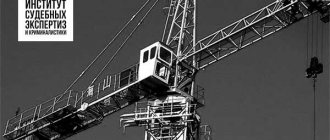Increasingly, most people are appointing a land management examination, as land development in our country is developing, more and more real estate and land plots are being purchased, not only for living, but also for business activities.
ATTENTION : our lawyer in disputes about the boundaries of land plots and other situations will help in the issue of appointing a land management examination, in drawing up questions for the expert, as well as in the process of appealing the examination: professionally and on favorable terms. Call!
Materials provided for conducting land management examination
The full list of materials transferred to the expert for conducting a land management examination is determined in each specific case, depending on the final purpose of the study. In most cases, to conduct an analysis you must provide:
- The exact address of the location of the disputed land plot (or plots).
- Title documents (registration certificates, purchase and sale agreements, etc.).
- Extracts from the cadastral chamber.
- Cadastral passport of the property.
- List and description of buildings on the land plot.
- Other available materials.
Who has the right to conduct an audit?
Any examination requires deep special knowledge from the person conducting it, therefore land management examination in Yekaterinburg, Moscow, St. Petersburg or another city should be carried out exclusively by licensed experts. They can be independent expert organizations or private experts who have been licensed for geodetic and cartographic activities by Rosreestr.
Private experts are called cadastral engineers. They can carry out their activities only after passing the exam and receiving a qualification certificate.
A land expert can act as an individual entrepreneur, a member of an association of cadastral engineers, or work in an independent expert organization.
Like appraisers, appraisers must have liability insurance.
The procedure for conducting a land management examination
Cadastral engineers and surveyors have the right to conduct land management examinations. A cadastral engineer is a specialist (individual) who has a qualification certificate or certificate valid at the time of carrying out professional activities. A cadastral engineer has the right to carry out cadastral activities, that is, maintaining a state register of land plots acting as real estate objects. The cadastral engineer carries out all the activities necessary to enter land plots into the register, as well as to make changes to the information contained in the cadastral register. A surveyor is an engineer who has the necessary body of knowledge in the field of geodesy and carries out geodetic work. Geodesy is a science that, in a broad sense, studies the measurement of space. In a narrow sense, geodesy is associated with the process of carrying out land management activities. Geodetic work includes all the necessary measurements on the ground - calculating the lengths of segments, the sizes of plots, their exact areas, determining the geographical coordinates of specific points that describe the location of a land plot in space. Through geodetic methods, the dimensions and shapes of land plots are transferred to paper with the greatest possible accuracy.
Land management examination can be carried out by a state expert bureau, an independent expert center or a private expert who has a license to carry out geodetic activities. Independent organizations conducting land management examination are required to have a license to carry out geodetic activities. If the expertise of both a cadastral engineer and a surveyor is required to carry out the examination, then a commission examination is carried out in which both specialists participate. To conduct simple and commission examinations, you can involve more than one specialist in each subject area. As a rule, this is done to resolve complex precedent issues that arise in the consideration of controversial cases.
At the first stage of the land management examination, specialists familiarize themselves with the available preliminary information and draw up an agreement to conduct the examination. This agreement must include the subject of the study - a list of certain characteristics of this land plot. In accordance with the subjects of the examination, the main areas of activity of the experts, the composition of the expert commission (or the expert’s specialty) are determined, a number of tasks are drawn up that will be solved by the specialist, as well as a list of questions, the answers to which will be given during the examination process. The tasks of the examination and questions to the expert must be included in the contract. A standard contract also includes the timing of the study, the cost of the specialist’s services, as well as mandatory paragraphs of any contract describing the procedure for interaction between the parties, their responsibilities, the procedure for action in the event of force majeure, and so on.
At the second stage, the actual research is carried out. Based on the studied documents provided and the activities carried out on the ground, the expert solves the tasks assigned to him and forms his professional expert opinion regarding the questions asked to him.
The final stage of the land management examination is the preparation of an expert opinion. The main purpose of conducting research for the client is to obtain this very conclusion, which can be included as evidence in the case during the judicial review of property land disputes. In addition, the conclusion can be used as a convincing argument in various conflict situations related to land disputes. The conclusion must be signed by the specialist or group of specialists who conducted it. If the study was carried out by a commission of experts of the same professional competence, and they did not come to a consensus on the issue under study, then all conclusions, even contradictory ones, are included in the conclusion. The expert who conducted the analysis may be summoned to court to explain and justify his conclusions, as well as to give testimony in one way or another related to his professional activities and the examination he carried out.
How long does the court procedure last?
Experts will issue a conclusion on the land within ten days, sometimes longer. It depends on the complexity of the work.
Typically the work takes place in three stages:
- preparatory work (studying all possible documentation on the case); field work (study of a site on the ground);
- final works (detailed information).
Please note: according to Regulation 214 “On State Expertise of Land Management Documentation”, the period for carrying out expert work can be set at 14 days.
Work on land management examination is carried out in strict accordance with the requirements of the following regulatory documents:
- Land Code of the Russian Federation dated October 25, 2001 No. 136-FZ;
- Federal Law “On Land Management” dated June 18, 2001 No. 78-FZ;
- Federal Law “On the State Real Estate Cadastre” dated July 24, 2007 No. 221-FZ;
- Civil Code of the Russian Federation;
- Housing Code of the Russian Federation;
- Town Planning Code of the Russian Federation;
- Resolution of the Plenum of the Supreme Court of the USSR dated July 31, 1981 No. 4;
- Resolution of the Plenum of the Supreme Court of the USSR dated June 10, 1980 No. 4;
- SanPiN 2.2.1/2.1.1.1076–01 “Hygienic requirements for insolation and sun protection of residential and public buildings and territories”;
- Collection of standards for assessing buildings owned by citizens of the Moscow region, vol. 1, Moscow, 1982;
- SP 30-102-99 “Planning and development of low-rise housing construction areas”;
- SNiP 2.07.01–89 “Urban planning. Planning and development of urban and rural settlements";
- SP 31-106-2002 “Design and construction of engineering systems of single-apartment residential buildings”;
- SNiP II-26-76 “Roofs”
- Reference manual for SNiP 2.08-01-89 “Design of residential buildings. Space-planning solutions";
- A. Yu. Butyrin. Theory and practice of forensic construction and technical examination;
- Instructions for land surveying. Roskomzem, 1996;
- Methodological recommendations for conducting land surveying of land management objects (approved by the Federal Land Cadastre Service of Russia on February 17, 2003)
Land management expertise is used if there is a dispute
- about the boundaries of a land plot in court;
- on invalidating the results of land surveying;
- on restoration of the boundaries of a land plot in court;
- on confirmation in court of the location of the boundaries of the land plot;
- on ensuring travel or access to a land plot;
- about the impossibility of establishing an easement on a land plot;
- on the establishment of an easement in relation to a land plot;
- about non-compliance with fire breaks (fire distances) between buildings on adjacent land plots;
- on determining the procedure for using a land plot;
- on recognition of ownership of a land plot;
- on the division of land between heirs.
PRE-JUDICIAL LAND MANAGEMENT EXAMINATION
Often, the initiators of pre-trial land management examinations are the owners of plots. Owners can be:
- natural person;
- business entities;
- government agencies, as well as legal authorities.
In this case, a formal agreement is concluded between the organization of experts and the landowner.
The conclusion of such an examination always includes:
- technical data relating to the plot of land being studied (including its location);
- information about the company that conducted the research;
- type of examination;
- timing of work;
- stages of research.
Basic methods and directions of land management examination
All methods of conducting land management examination are divided into two large groups - the study of existing documents that in one way or another describe the disputed land plot (or plots) and the direct study of the land plot itself.
Documentary methods are associated with the study of cadastral records and title documents. Experts analyze available paper evidence, restore the procedure for entering information or changes into registers, and confirm (or refute) the legality of these actions. A detailed analysis of the site descriptions, its shape, size, area and location is carried out. A preliminary conclusion on the disputed areas is drawn up. Subsequently, the data obtained from the provided documentation is compared with data obtained from direct measurements of sites on the ground.
Geodetic methods of land management examination include:
- Field measurements. Obtaining characteristics of land plots using special instruments.
- Desk processing is a set of works related to the analysis of “raw” data obtained during field measurements, including experimental computer modeling of the environment based on available field calculations. It is carried out using computer technology - specialized software.
Field measurements are carried out using special geodetic instruments. The following types of instruments are used in land management examination:
- Total stations.
- Theodolites.
- Laser rangefinders.
- Levels.
- GPS equipment.
Tacheometers are devices that allow you to measure distances, horizontal and vertical angles on the ground. It is also used to determine the coordinates and heights of specific points on a land plot. A tacheometer is one of the most popular geodetic instruments, as it performs a large number of different measurements. Measurements in a total station are based on the principle of a reflected light beam. Currently, electronic total stations are mainly used. Each device has its own degree of angular measurement error, which is measured in seconds. The error of angular measurements of tacheometers must be taken into account by the expert when drawing up his professional opinion.
Theodolites are used to calculate angle values. There are two types of theodolites - optical and electronic.
Laser rangefinders measure lengths and horizontal distances.
Levels are designed to measure the difference in height of two given points on the ground. In geodesy, such a difference is called excess.
GPS equipment calculates the coordinates of turning points of land and real estate located on it.
Research methods
Research methods are divided into several groups. Geodetic surveys are carried out using levels, laser tape measures and other measuring instruments. The site itself is surveyed to identify the actual boundaries. Using computer programs, a plan is drawn up that corresponds to the actual state of affairs. It is used to check with boundary signs to ensure that the boundaries correspond to the actual boundaries. To assess the condition of the soil, analyzes and tests are performed, and samples are taken.
The documentary method involves the analysis of legal and graphic information related to the object of research. Thanks to this method, errors in documentation are found and recommendations are provided for correcting information in the cadastral register. The research methods used must be indicated in the research part of the conclusion. It contains the signature of a specialist and his regalia, as well as the seal of a legal entity, on each page.
State or independent examination is carried out by court decision at the request of the parties. When the conclusion is ready, it is submitted to the court, where participants can familiarize themselves with its contents. The second party can challenge the expert (if there is a reason) and contact other experts. This makes it possible to challenge the conclusion of the first land examination by providing new facts. A pre-trial independent examination can be carried out at any stage, initiated by any party, with the issuance of a written opinion or oral recommendations.
Legal basis for conducting land management examination
The unprecedentedly important process in modern Russia of determining the boundaries of land plots and fixing them directly on the ground is known as land surveying. Land surveying is carried out in accordance with the Instructions on land surveying, approved by the Russian Committee on Land Resources and Land Management (Roskomzem) on April 8, 1996. On February 28, 2003, the Russian Unified Register of Land Ownerships (Roszemkadastr) published a letter clarifying the procedure for using the above-mentioned Instructions. The instructions include a list of preparatory work and a list of documents to be provided. Both when performing preparatory work and when creating a package of documents, the results of the land management examination are used.
Questions answered by a land management expert
- What is the actual area of the land plot under study?
- Does the actual area of the plot located at the specified address, determined during the examination, correspond to the area declared in the title documents?
- Is there an overlap between the boundaries of these land plots (with corresponding cadastral numbers)?
- Is the defendant’s property located on the plaintiff’s land plot (located at the specified address, having the specified area and cadastral number)?
- Does the actual location of the defendant's property in the area correspond to its location entered in the documentation?
- What are the geographic coordinates of the corner (turning) points of the land plot under study?
- What is the total area of the intersected parts of these land plots?
- What is the area of land free from development?
- What is the area of land occupied by buildings?
- What are the coordinates of the corners of the building located on the land?
- Is it possible to construct a real estate property on the land plot under study?
- What is the possible area of construction that can be erected on this plot of land?
- Do the land management work carried out on the study site comply with current legislation?
- Are special development rules observed when carrying out land management work on the land plot under study?
Two types of examinations
- Judicial . This type includes studies ordered by the court. One of the parties to the trial may make an application for the appointment of a forensic examination. In a trial, it can become the main evidence. This type of research can only be ordered by a court.
- Pre-trial. Pre-trial examination is carried out privately. A citizen, at his own request, turns to specialists to take measurements on his site. This may be required when registering land, selling or buying it, as well as during any other actions with it.
Land management expertise is divided into three types:
- Examination of the division of land . One of the most popular types of land management expertise, the purpose of which is the division of a land plot in kind between the owners.
- Examination of boundary works . It is mainly of a pre-trial nature and consists of a range of services in geodesy and cartography.
- Examination of the removal of land boundaries . It can be both pre-trial and judicial in nature and consists of a range of services for the removal in kind of the boundaries of a land plot.
What are the challenges facing land management forensics?
1. Definition and reflection on the plan:
- actual boundaries of the land plot;
- the actual order of use of the land plot by co-owners;
- the area of land occupied by each of the co-owners;
- compliance of the actual boundaries of the land plot with the boundaries indicated in the title documents and determination of the area of discrepancy;
- market, cadastral value of land plots for various purposes, easement value.









